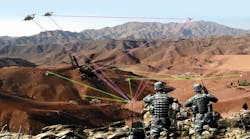Rockwell Collins continues to evolve its software-defined-radio (SDR) communications equipment technology, recently receiving a Type-1 top secret (TS) certification from the National Security Agency (NSA) for its latest-generation ARC-210 RT-2036(C) airborne radio. The SDR provides secure, reliable communications for warfighters on the ground and in the air (Fig. 1).
1. SDR technology provides secure reliable communications to armed forces on the ground and in the air. (Courtesy of Rockwell Collins)
“This NSA certification is one of the final steps in getting our latest-generation airborne radio technology into the field,” says Troy Brunk, vice-president and general manager, Communication, Navigation and Electronic Warfare Solutions for Rockwell Collins. “With data, images, voice, and video being sent from the air to the ground in real time, warfighters will have critical information at their fingertips to gain a tactical advantage on the battlefield.”
The ARC-210 RT-2036(C) SDR (Fig. 2) provides advanced communications capabilities, such as the U.S. Department of Defense’s (DoD) Mobile User Objective System (MUOS), for which it’s undergoing conformance testing with the U.S. Navy. The RT-2036(C) radio also meets the requirements for the Second-Generation Anti-Jam Tactical UHF Radio for NATO (SATURN) program while maintaining interoperability with legacy radio waveforms.
2. The ARC-210 RT-2036(C) will enable U.S. Armed Forces to tap into new communications capabilities such as the U.S. DoD’s MUOS program and Second-Generation Anti-Jam Tactical UHF Radio for NATO (SATURN) program. (Courtesy of Rockwell Collins)
Rockwell Collins recently received a five-year IDIQ contract from the Navy for production deliveries of the ARC-210 RT-2036(C) radio. The radio features an open architecture that supports legacy radio waveforms and allows for software-based upgrades as needed. It operates over an extended frequency range compared to legacy military radio designs and implements the latest NSA algorithms and modernized Electronic Counter Countermeasures (ECCM) functions.



